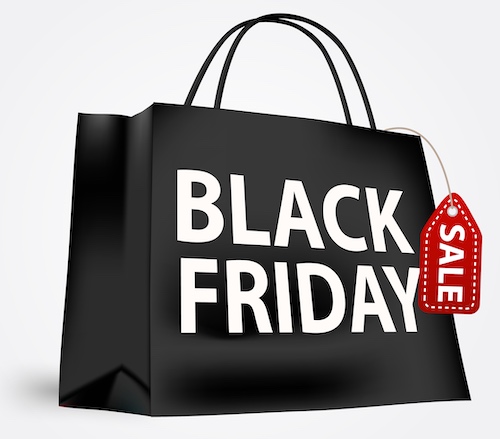“Last year alone, our data show that an estimated $482 million were lost on Black Friday from Millennial shoppers who unwittingly bought fakes online.
 Black Friday is one of the most important retail events of the year for brands and consumers alike. Last year, Adobe Analytics recorded a 17.9 percent increase in online sales across the 100 largest U.S. web retailers for a total of $7.9 billion in revenue. This year is no exception with sales expected to reach a record high.
Black Friday is one of the most important retail events of the year for brands and consumers alike. Last year, Adobe Analytics recorded a 17.9 percent increase in online sales across the 100 largest U.S. web retailers for a total of $7.9 billion in revenue. This year is no exception with sales expected to reach a record high.
This sales event is particularly tempting for price-centric Millennials whose diverse buying habits put them at increased risk of falling for fakes. Representing one of the biggest Black Friday consumer segments, they are particularly vulnerable to counterfeiters. Last year alone, our data show that an estimated $482 million were lost on Black Friday from Millennial shoppers who unwittingly bought fakes online. This is why understanding Millennial spending behavior can help brands worldwide better protect customers against counterfeiting threats. Our most recent survey, carried out with 1,000+ Millennial shoppers, provides insights into Millennial attitudes and behavior to help brands mitigate the impact of Black Friday on business margins.
Understanding consumer behavior and the associated risks
Shoppers have many options as far as where to make purchases, but when it comes to buying behavior, they fall into one of two categories: impulse buyers and planners. This year, 73% of millennials plan on shopping online for Black Friday versus 23% in-store, with a quarter of shoppers likely to make impulse purchases. Both are targets for counterfeiters on Black Friday, but the risks for each and what they mean for brands vary.
Planned purchase behavior is characterized by having a specific item or items in mind, researching products, comparing prices, reading reviews and comments, and discussing the purchase with friends and family. Planned purchases often concern high-value items. When shopping online, planners are likely to investigate leading e-commerce websites, brand websites, and other channels in their search for the best value. A planner’s buying journey, therefore, offers many opportunities for brands to monitor and control the appearance of counterfeit products.
Impulse purchase behavior is characterized by impulsive decisions taken with little or no forethought. Impulse purchases are emotionally driven and often provoked by deals or discounts. These shoppers are particularly vulnerable to enticing ads on social media promising fast, easy, and cheap deals. Protecting this unpredictable shopper from counterfeiters requires a more nuanced approach to brand protection.
An online brand protection strategy is critical on Black Friday
According to a report from the OECD, the global trade in fake goods is worth nearly half a trillion dollars a year, or around 2.5 percent of global imports. This represents a significant challenge to brands seeking to protect Black Friday margins, especially when changing Millennial shopping habits are added to the mix.
Many Millennials no longer shop off a list, instead letting themselves be guided by ads and promotions: 27 percent of our survey respondents report they intend to make impulse purchases on Black Friday based on offers they see. This makes the event a potentially very lucrative time for counterfeiters, especially given that impulse buyers are twice as likely to fall for fakes as planners are: 37.2 percent of survey respondents who unwittingly purchased a fake did so during a planned purchase — 62.7 did so during an impulse buy.
It will come as no surprise that electronics are a popular Black Friday purchase, as these often high-value products tend to be heavily discounted. Indeed, our survey indicated that 24% of respondents said they plan on buying electronics this year. Worryingly, these products also happen to be among the fastest growing categories of counterfeited goods, which can pose real safety concerns for consumers.
Strong brand protection reflects actual consumer behavior
As technology evolves, so does consumer behaviour—and so do the strategies employed by counterfeiters. An effective brand protection solution considers the many different aspects of the buyer’s journey and offers tailored responses to planned and impulsive behavior.
Safeguarding traditional e-commerce platforms where the majority of planned purchases take place (and where counterfeiters thrive) is a smart first step. But a full quarter of Millennials are expected to engage in online impulse shopping, which will likely lead them to social media platform where they will become targets for counterfeiters. Does your brand protection strategy account for the variety in Millennial shopping habits this Black Friday?
Image Source: Deposit Photos.

![[IPWatchdog Logo]](https://ipwatchdog.com/wp-content/themes/IPWatchdog%20-%202023/assets/images/temp/logo-small@2x.png)

![[Advertisement]](https://ipwatchdog.com/wp-content/uploads/2024/04/Patent-Litigation-Masters-2024-sidebar-early-bird-ends-Apr-21-last-chance-700x500-1.jpg)

![[Advertisement]](https://ipwatchdog.com/wp-content/uploads/2021/12/WEBINAR-336-x-280-px.png)
![[Advertisement]](https://ipwatchdog.com/wp-content/uploads/2021/12/2021-Patent-Practice-on-Demand-recorded-Feb-2021-336-x-280.jpg)
![[Advertisement]](https://ipwatchdog.com/wp-content/uploads/2021/12/Ad-4-The-Invent-Patent-System™.png)







Join the Discussion
No comments yet.